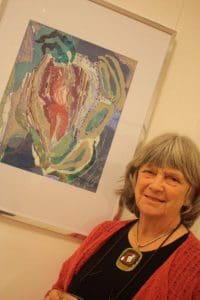
Marwick Wreck, Orkney. Paint, ink and collage. By Paul Janssens.
New exhibition Figuratively Speaking dazzles at London’s Espacio Gallery: shipwrecks, sculpture and scrunched-up tissue, By James Brewer
Co-ordinating a show spanning abstract canvases, feminist art, sculpture, and powerful scenes of ships wrecked off northern Scotland, is a big test. As curators, London artists Virginia Waterhouse and Eleanor Buffam triumphed in making sense of an unbounded miscellany, as the show Figuratively Speaking opened at the co-operative venture Espacio Gallery in Shoreditch.
Painter and musician Eleanor brought to bear her experience of taking part in and organising many shows, while Virginia, who took up painting and printmaking after years in the education profession, has been involved in a dozen group shows in almost as many months.

Moira Purver with her bronze resin sculpture Moment to Ponder.
Their task was to hang coherently the offerings of 11 artists with the loosest of connections except for “a shared visual understanding of the world as an exciting place to be explored and represented, ” and an experimental approach to materials at hand. The sure touch of Eleanor and Virginia throughout the two spacious floors of the gallery, which is a short stroll from Brick Lane, the home of another variety of cosmopolitanism, was manna from heaven for the doughty eleven.
Since its launch in 2012, Espacio has managed to stay clear of outright commercialism by winning the support and embracing the talent of dozens of UK-based artists. The brainchild of Brazilian painter Carlos de Lins, Espacio was founded, says its website, by a group of artists working across all contemporary visual arts media who wanted a space of their own specially designed to meet their needs.
The gallery is funded by 100 subscribing artist members and by being let on occasion to other artists and projects. The mission statement says: “We believe that making art is about communication and to communicate, in an ideal world, artists should be able to have their own platform where they get a chance to show, discuss, engage and share their vision with an audience.”
The most outwardly dramatic statement of the show came from keen traveller Paul Janssens, in the shape of his large maritime-themed works. They were the result of London-born Paul immersing himself in the misty and mesmerising atmosphere of Orkney, far from his current Cambridgeshire base. Orkney’s wild weather – it suffers 30 days of gales on average a year – fires every artist’s imagination, and Paul piles on many layers of its moods, in paint, ink and collage.

Virginia Waterhouse with her works Head in the Clouds and Sunset Touch
His grand Marwick Wreck, Orkney, is embellished by a restless sky which turns out on close inspection to include superimposed shreds of ordnance survey maps. Breaking the Surface, Orkney Blockship, the Reginald shows the capsized hull of a 930 gt three-masted iron schooner scuttled in 1915 as a blockship in shallow waters of East Weddel Sound. Such ships as the 1878-built Reginald were sunk to deter possible German attack on the Royal Navy base Scapa Flow. More recently, the Reginald is said to have been used by fishermen to hold their creels (baskets for fish). Keenly attuned to the marine environment, Paul uses fragments of wood as a base for some of his paintings.
V irginia Waterhouse is at the opposite end of the visual spectrum, with abstract paintings directly inspired by music and poetry, and oil paintings that she describes as dream-like, inviting the viewer to supply their personal interpretations of what they see. Thoroughly versed in the education world, Virginia studied at the adult education institutes City Lit and the Mary Ward Centre before graduating in Fine Art from the Sir John Cass School of Art, London Metropolitan University, in 2012.
Eleanor Buffam catches the attention through transferring her photographic vision to a flair for acrylics, with bold scenes in compelling colour of daily life and its emotions.
Devon-born Wendy Roberts conveys a primal atmosphere in her mixed media work Jurassic Coast. She graduated as a mature student in 2009 from Sir John Cass Art School, and her skills in etching are evident in a multi-faceted impress upon the canvas. She has used varied recycling techniques including crumpled tissue paper, and chalk-edged envelope strips, with spots of acrylic paint, the whole becoming an evocation of an era when human life was still bubbling beneath the surface of the earth.

Wendy Roberts with her mixed media work Jurassic Coast
Appealing, gently curved, female figures are a constant for prolific sculptor Moira Purver, who brings a sure touch to her favoured material, bronze resin. The sculptures call to mind what James Joyce wrote: “Men are governed by lines of intellect – women, by curves of emotion.” Moira works largely from life (in the case of one of her exhibits here, Moment to Ponder, from a patient model named Tanya), which gives her output a harmonious and reassuring aura.
Bronze resin is a strong material, and the main strength of the method used is that it does not need a furnace, in contrast to expensive traditional casting. The resin process was developed in 1959 by John Tiranti of the firm Alec Tiranti Ltd, paving the way for sculpting to be feasible for many more practitioners.
The process starts with sculpting an original from clay, and coating a silicone rubber mould with resin containing powdered bronze and kept rigid during pouring by a fibreglass jacket. Moira prefers a ratio of five to one of bronze to resin in the blend. The surface can be given a patina, effecting an appealing metallic finish. Moira, an associate member of the Society of Women Artists, said: “What I like about bronze resin is that it makes sculpture much more accessible, and affordable so that it can be sold to people who have never bought a sculpture before: it is opening up a different field of art to people used to buying paintings.”
For more than 20 years, London artist Mali has produced variations on the form and content of the book as a concept. The latest chapter to evolve includes a 3D mixed media work After Dali? (Mali is not coy that his name rhymes with that of the great surrealist); a paper-cut Early Morning Pages looking like a swarm of butterflies; and a striking photograph Long Walk to Freedom, produced long before the death of Nelson Mandela, for a series started by Mali in 2007.

After Dali? Mixed media. By Mali.
Deeply personal insights into her life are tendered by feminist Marta Boros in her collages, but they are equally a comment on society at large. In one of her spirited, brash and fearless works, she clamps a women’s fashion store receipt alongside self-portraiture and sexual imagery to underline the fact that much modern female attire is ultimately a commercial, exploitative product.
Full list of the exhibitors is Marta Boros, Eleanor Buffam, Marianne Frank, Paul Janssens, Helga Lee, Mali, Lucy Morton, Moira Purver, Jones Tensini, Wendy Roberts and Virginia Waterhouse.
Figuratively Speaking is at Espacio Gallery, 159 Bethnal Green Road, London, E2, until February 25 2014. Details at www.espaciogallery.com





